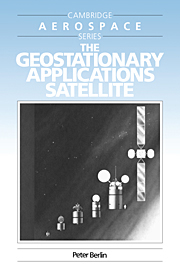Book contents
- Frontmatter
- Contents
- Dedication
- Preface
- List of Acronyms
- 1 Launch vehicles
- 2 The transfer orbit
- 3 The geostationary orbit
- 4 The satellite environment
- 5 Structures
- 6 Mechanisms
- 7 Thermal control
- 8 Power supply and conditioning
- 9 Propulsion and orbit control
- 10 Attitude stabilization, measurement and control
- 11 Telemetry, tracking and command (TT&C)
- 12 Communications payload
- 13 Meteorological payload
- 14 Product assurance
- 15 Spacecraft development and testing
- Index
8 - Power supply and conditioning
Published online by Cambridge University Press: 02 February 2010
- Frontmatter
- Contents
- Dedication
- Preface
- List of Acronyms
- 1 Launch vehicles
- 2 The transfer orbit
- 3 The geostationary orbit
- 4 The satellite environment
- 5 Structures
- 6 Mechanisms
- 7 Thermal control
- 8 Power supply and conditioning
- 9 Propulsion and orbit control
- 10 Attitude stabilization, measurement and control
- 11 Telemetry, tracking and command (TT&C)
- 12 Communications payload
- 13 Meteorological payload
- 14 Product assurance
- 15 Spacecraft development and testing
- Index
Summary
Introduction
By the time the light emanating from the sun reaches the geosynchronous earth orbit, its energy content has been reduced to approximately 1350 W/m2. Hence, if all of the light that falls on a 1 m2 surface could be converted to electric power, it would be just enough to run an electric iron. In practice, only 10–14% can be thus converted with today's technology. The engineering challenge facing a satellite designer is to draw on this meagre solar energy to operate and heat an entire spacecraft, and to transmit radio waves with sufficient signal strength to be received intelligibly on the earth some 36 000 km away.
This chapter describes how electric energy is generated, conditioned and stored onboard geostationary satellites.
Subsystem Architecture
The main building blocks are the solar array, the battery and the loads (Fig. 8.1). The solar array is made up of strings of photovoltaic cells cemented onto solar panels. The battery is charged by the array during sunlight so as to provide power in eclipse when the array is idle. The loads are the users of electric power, such as transmitters, receivers, microprocessors, electric motors and heaters. The battery can also be considered a load while it is being charged.
A satellite power subsystem contains switches to turn on or off various load combinations and to protect the battery from overcharge or depletion. Some of the switches are triggered automatically when certain conditions arise, while others are activated by telecommand.
- Type
- Chapter
- Information
- The Geostationary Applications Satellite , pp. 92 - 104Publisher: Cambridge University PressPrint publication year: 1988



